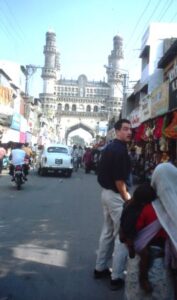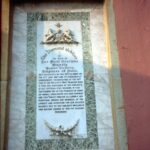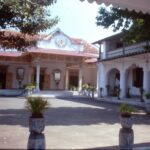Carolyn could easily have rented my room in spring 1997, when I took my only sabbatical from IWU. My ambition was to use it to learn about working and living abroad; I had lined up an internship with Motorola, but the impending Asian Financial Crisis put paid to that idea. Instead, I wrote a paper for a conference that would take me to Hyderabad, and introduce me to South Asia, allowing me to add to my expertise on the Far East.
 Actually, Carolyn could have rented the whole house in January 1997, because she and David accompanied me on the journey. Before we sent Carolyn back (she didn’t have a sabbatical!), we had explored Bombay (Mumbai), Hyderabad (with the Golconda and the Char Minar), Delhi
Actually, Carolyn could have rented the whole house in January 1997, because she and David accompanied me on the journey. Before we sent Carolyn back (she didn’t have a sabbatical!), we had explored Bombay (Mumbai), Hyderabad (with the Golconda and the Char Minar), Delhi (where we were hosted by the family of one of my students), and with their help, patched together Jaipur (elephants and pink city), Agra (transfixed by the Taj Mahal), Fatehpur Sikri (Akbar’s abortive capital), and for good measure, a short trip to Benares and the holy city of Hinduism, to balance the Moghul/British architecture elsewhere. We even got to stay in a
(where we were hosted by the family of one of my students), and with their help, patched together Jaipur (elephants and pink city), Agra (transfixed by the Taj Mahal), Fatehpur Sikri (Akbar’s abortive capital), and for good measure, a short trip to Benares and the holy city of Hinduism, to balance the Moghul/British architecture elsewhere. We even got to stay in a 
palace (remnant of the India before independence, when it was partly British, partly princely states).
What an introduction to South Asia, and its contrasts. Incredible food, history, color–but in sight of the most expensive real estate in the world (the Malabar coast, I’m told), the slum of slumdog millionaire.
 Fascinated, I knew I’d have to come back sometime; after all, every page in the Lonely Planet screamed, “Visit me!” And I knew I’d have to bring my students to see this part of what was rapidly becoming the Asian Economic Miracle. And some of you reading this, for better or worse, had that chance.
Fascinated, I knew I’d have to come back sometime; after all, every page in the Lonely Planet screamed, “Visit me!” And I knew I’d have to bring my students to see this part of what was rapidly becoming the Asian Economic Miracle. And some of you reading this, for better or worse, had that chance.











